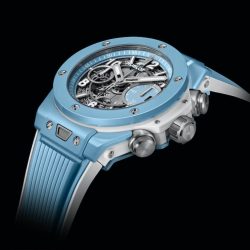You have probably heard the name Gérald Genta countless times if you have an interest in USA perfect replica watches design. His name is synonymous with two of the most successful wristwatch lines in the modern era; the Audemars Piguet Royal Oak and the Patek Philippe Nautilus. Numerous iterations have spawned from these core designs. And in the case of Audemars Piguet, the Royal Oak is the cornerstone of the brand’s design DNA, even 50 years after its birth.
So how did it come to be that two of the “holy trinity” Grand Maisons ultimately owe these successes to not just one designer, but the very same man? To understand this, you first have to understand the man himself — Gérald Genta, a legend of 20th-century Swiss watchmaking.
Starting with the basics
Charles Gérald Genta was born on May 1st, 1931 in Geneva, Switzerland. Throughout his 80 years on Earth, he blazed a trail through the watchmaking industry that still smolders to this day. He is survived by his wife Evelyne, whom he married at a grand wedding in Monte Carlo. In addition to her duties as a Monégasque ambassador for the United Kingdom, Evelyne maintains her late husband’s legacy alongside the couple’s daughter, Alexia. The familial duo established the Gerald Genta Association in 2019.

The Audemars Piguet Royal Oak Replica Watches was born 50 years ago
One such brand was high quality Audemars Piguet fake watches. As the story goes, AP contacted Genta with a rather far-reaching request. The remit? To conceive a new watch-design language. The timeframe? The next working day. Genta duly accepted and sketched his ideas overnight. Audemars Piguet presented Genta’s work to its investors. Although one could well imagine a confused response to the avant-garde proposal, the results sufficiently impressed the investors, and they signed off on the design. As you may have already guessed, this overnight epiphany came to be known as the Royal Oak (after narrowly escaping being named the Audemars Piguet Safari). This took place a whole 50 years ago, and AP is currently celebrating with a number of special releases.
Core to the concept was the seamless link between the bracelet and the case of the watch. Before this, the protruding lugs of a watch were a clear delineation between the head of the best replica watches and the strap or the bracelet. The introduction of an integrated bracelet proved a seminal moment for wristwatch design. The unified case and bracelet gifted the Royal Oak with a fluid appearance, which led to the bracelet being considered one of the all-time greats.
Step into the octagon
One of the most recognizable aspects of the design is the octagonal bezel. While many believe it was inspired by a ship’s porthole, Genta stumbled across the idea when observing a diver’s helmet. He was taken by the raw functionality of the exposed screw heads and decided to incorporate the idea into his design. It turned out to be yet another flash of brilliance. In luxury Swiss copy watches (especially up until that point), designers attempted to achieve the appearance of flawlessness. Watches had to look like they had come into existence without the need for human intervention. By celebrating something as functional as a screw (or, as in the case of the AP Royal Oak, a bolt) Genta kicked down the door that led to the subsequent generations of experimental design.
While many assume that the bolts are non-functional (as the general assumption is that they are screws rather than bolts held in place by corresponding nuts tightened from the underside). The genuine functionality of this design element sends a message — that the process is to be as celebrated as the result. The only design flourish is the positioning of the grooves, which correlate with the lines of the octagonal case. The bolts themselves were made from white gold. This is because steel could not be precisely machined to the correct scale with the techniques of the time.
Reaching iconic status
While the success of top Audemars Piguet replica watches today is undeniable, back in 1972, the Royal Oak was not a clear-cut hit. The market was not ready for a luxury sports watch in stainless steel that was priced and treated like gold. It was priced sometimes ahead of the brand’s gold pieces and four times more than a Rolex Submariner of the time. This carries over somewhat into today’s market too. It’s an adage that designs can sometimes be “ahead of their time”, but in the case of the Royal Oak, it rings true. Genta’s singular vision was to conceive styles that exude luxury despite the utilitarian material of stainless steel. Fifty years later, the cheap super clone watches’ iconic status speaks for itself.

The Patek Philippe Nautilus Fake Watches is born
From there, the Royal Oak gathered steam with more marketing investment brought in by a young Jean-Claude Biver. In Basel, during the annual watch fair, Genta was enjoying a quiet dinner in a hotel restaurant when he spotted some Patek Philippe executives wining and dining. He requested a pencil and paper from the waiter. In just five minutes, he sketched a new concept that would suit Patek’s lineup. His thinking was to soften the sharp edges of the Royal Oak. The idea was to offer a less masculine watch, more suitable for ladies’ wrists. He shared his designs with Patek, who did not immediately embrace the look. However, the brand did see potential in allowing the Swiss movements replica watches to be enjoyed equally by both genders.
This notion went on to become the 1:1 wholesale fake Patek Philippe Nautilus watches. Given the timing of Genta’s approach, the idea that Patek imitated the Royal Oak concept hoping to piggyback on its success does not check out, as Audemars Piguet were far from seeing a solid return on their investment in the radical release. Rather, it is thanks to Genta’s singular vision and indomitable self-belief that the Nautilus followed the Royal Oak into production.
Patek Philippe’s Nautilus replica watches online shop carried over the nautical themes seen in the Royal Oak but significantly streamlined the design. An unusual hinged case (resulting in the iconic “ears” of the Nautilus) set the design apart from its peers. As with the Royal Oak, Genta was keen to blend the industrial with the divine. Thus, he left the screws exposed on the sides of the bracelet, juxtaposing with the luxurious surface finishing of the bracelet and bezel, and the moody, maritime-inspired dial. Forty-six years since its release in 1976, the Nautilus remains one of the most sought-after models the industry has ever seen.

